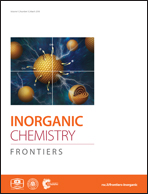VO2(D) hollow core–shell microspheres: synthesis, methylene blue dye adsorption and their transformation into C/VOx nanoparticles†
Abstract
In this work, we report the fabrication of novel VO2(D) hollow core–shell microspheres (VO2(D)-HCSMs) via a facile hydrothermal method. Microscopic examination revealed that the VO2(D)-HCSMs consisted of numerous nanocrystals and had an average size of 1–10 μm and a shell thickness of 300 nm. An inside-out Ostwald ripening process was responsible for the formation of the VO2(D)-HCSMs. Meanwhile, citric acid played dual roles, acting as a reductant for reducing vanadium pentoxide and as a morphology directing agent for producing core–shell microspheres. The resulting VO2(D)-HCSMs exhibited excellent adsorption performance with a maximum adsorption capacity of 97.5 mg g−1 for methylene blue (MB). The C/VOx particles were generated by the calcination of the VO2(D)-HCSMs with adsorbed MB dye at 250 °C in air for 4 h, and the microspheres showed enhanced adsorption capacity and good reusability (over 99% MB removal after four cycles) because of the existence of amorphous carbon nanowires, making them a potential adsorbent for removing organic dyes from wastewater.



 Please wait while we load your content...
Please wait while we load your content...